| Sei in: Cinema e Medioevo ® Indice alfabetico dei film |
Jeanne captive
2011, regia di Philippe Ramos
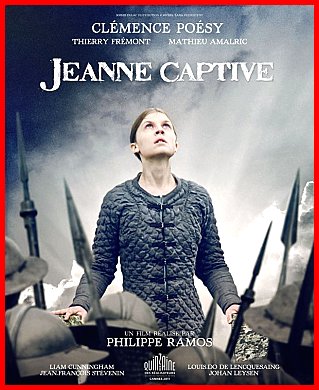
Scheda: Nazione: Francia - Produzione: Sophie Dulac Productions, Echo Films e altre società in compartecipazione - Distribuzione: Sophie Dulac Productions - Soggetto: Philippe Ramos - Sceneggiatura: Philippe Ramos, Camille Fontaine - Fotografia: Philippe Ramos - Montaggio: Philippe Ramos - Art Direction: Bruno Dumont - Costumi: Marie-Laure Pinsard - Effetti speciali: Fabien Feintrenie - Formato: Color - Durata: 92'.
Cast: Clémence Poésy, Mathieu Amalric, Thierry Frémont, Liam Cunningham, Louis-Do de Lencquesaing, Jean-François Stévenin, Johan Leysen, Bernard Blancan, Christopher Craig, Conrad Cecil.

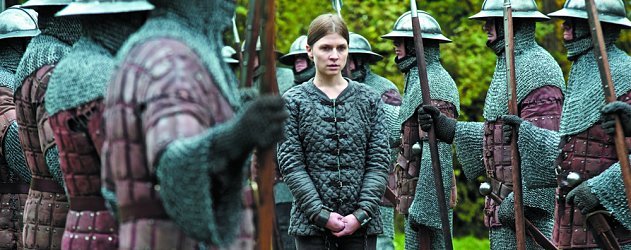
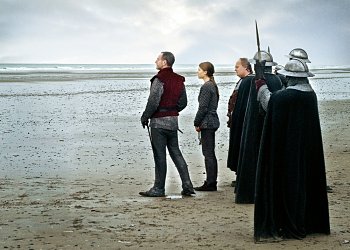
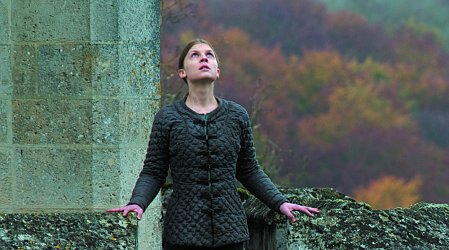
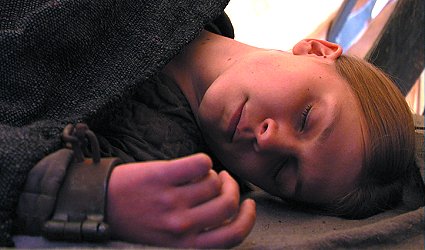
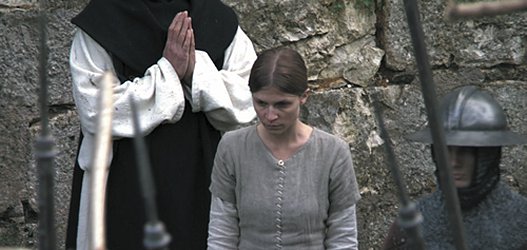
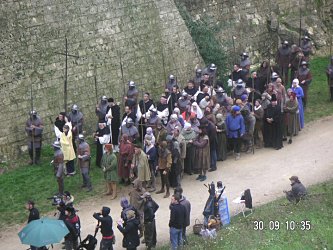
![]() Trama e commenti:
filmtv.it - cinematografo.it - movieplayer.it - pardo.ch - cineuropa.org - film.it - mymovies.it: «Anno
1430, Nord della Francia. Dopo i successi militari, Giovanna d'Arco si trova
prigioniera in un castello, prima di essere venduta agli inglesi. Si lascia
cadere da una torre del maniero, ma miracolosamente non muore. Viene trovata da
una pastorella che pensa sia caduta dal cielo. Riportata dietro le grate, non
sente più le voci divine e si chiede perché Dio l'abbia abbandonata. Decide così
di rimanere muta per rispondere al silenzio divino. "Il cinema non è una fetta
di vita, è una fetta di torta", diceva Hitchcock. Contravvenendo a questa
regola, Philippe Ramos racconta una parte della vita della Pulzella, che non è
stata ancora considerata una fetta di torta nei tanti film su di lei. Solo
Rivette l'aveva accennata, ma lui aveva a disposizione un film di quattro ore.
Ramos bypassa accuratamente tutte le battaglie per arrivare a questa lunga stasi
narrativa della prigionia. La fase successiva del processo è lasciata fuori
campo, in una didascalia, mentre il rogo è visto da un punto di vista terzo, da
lontano, quello del mendicante attraverso il gabbiotto in cui è stato rinchiuso.
Ogni paragone con Dreyer e l'imperituro volto della Falconetti, è così evitato.
Invece il film ci fa vedere da vicino le ceneri della Pulzella che vengono
sparse nel fiume, galleggiando fino a dissolversi nella corrente. Ramos sembra
voler fare luce su quello che finora il cinema aveva lasciato nell'ombra. E,
curando personalmente la fotografia, costruisce un film che si gioca
sull'alternanza di luce e ombra. Gira in location reali, castelli dai muri
incrostati e coperti di muschio, in luce naturale, con un rigore kubrickiano.
Gli interni sono sempre bui e illuminati solo da fonti diegetiche, spiragli che
arrivano da strette finestre o candele. ...» (Giampiero Raganelli).
Trama e commenti:
filmtv.it - cinematografo.it - movieplayer.it - pardo.ch - cineuropa.org - film.it - mymovies.it: «Anno
1430, Nord della Francia. Dopo i successi militari, Giovanna d'Arco si trova
prigioniera in un castello, prima di essere venduta agli inglesi. Si lascia
cadere da una torre del maniero, ma miracolosamente non muore. Viene trovata da
una pastorella che pensa sia caduta dal cielo. Riportata dietro le grate, non
sente più le voci divine e si chiede perché Dio l'abbia abbandonata. Decide così
di rimanere muta per rispondere al silenzio divino. "Il cinema non è una fetta
di vita, è una fetta di torta", diceva Hitchcock. Contravvenendo a questa
regola, Philippe Ramos racconta una parte della vita della Pulzella, che non è
stata ancora considerata una fetta di torta nei tanti film su di lei. Solo
Rivette l'aveva accennata, ma lui aveva a disposizione un film di quattro ore.
Ramos bypassa accuratamente tutte le battaglie per arrivare a questa lunga stasi
narrativa della prigionia. La fase successiva del processo è lasciata fuori
campo, in una didascalia, mentre il rogo è visto da un punto di vista terzo, da
lontano, quello del mendicante attraverso il gabbiotto in cui è stato rinchiuso.
Ogni paragone con Dreyer e l'imperituro volto della Falconetti, è così evitato.
Invece il film ci fa vedere da vicino le ceneri della Pulzella che vengono
sparse nel fiume, galleggiando fino a dissolversi nella corrente. Ramos sembra
voler fare luce su quello che finora il cinema aveva lasciato nell'ombra. E,
curando personalmente la fotografia, costruisce un film che si gioca
sull'alternanza di luce e ombra. Gira in location reali, castelli dai muri
incrostati e coperti di muschio, in luce naturale, con un rigore kubrickiano.
Gli interni sono sempre bui e illuminati solo da fonti diegetiche, spiragli che
arrivano da strette finestre o candele. ...» (Giampiero Raganelli).
![]() Plot Summary, Synopsis, Review: IMDb
-
allmovie.com
-
comingsoon.net
-
hollywoodreporter.com
-
abusdecine.com
-
dvdfr.com
-
outnow.ch
-
abandomoviez.net
-
quinzaine-realisateurs.com
-
sitgesfilmfestival.com:
«In 1430, young Joan of Arc, prisoner of a lord from northern France, is sold
to the British. Philippe Ramos, who presented his particular adaptation of “Moby
Dick”, Capitaine Achab, in this same section in 2008, does a brilliant
portrayal of the mythical figure Joan of Arc, whose life has been taken to the
silver screen on diverse and glorious occasions. Ramos shows his heroine between
the four walls that enclose her, on a marine convoy or near the stake where her
life will come to an end. Great names in French cinema like Mathieu Amalric or
Jean-François Stévenin round off this marvelous piece. If we set out to rewrite
the history of cinema based on its Joans of Arc, we might find that Méliès’
tablaux vivants give way to Dreyer’s passionate mysticism, that Victor Fleming’s
Hollywood epic contradicts Robert Bresson’s undressing or that the theatricality
drama of Rossellini’s Joan of Arc finds its counterpoint in the great fresco
that Jacques Rivette dedicated to the saint in the early nineties. All of these
examples, to which we can add Otto Preminger with a young Jean Seberg, are
simply an indication to us that Joan is a part of cinematic heritage and that
she’s become a key motif for many authors. What sense and what perspective could
a new Joan of Arc have today? This question simply highlights a serious problem
of perspective, which leads one to wonder how to be faithful to a disconcerting
legacy and be innovative at the same time. The curious thing about Philippe
Ramos’ Jeanne Captive is that it makes some of these questions its own.
The old legacy is present in the fact that Ramos decides to focus on Joan of
Arc’s final moments, the passion and the process that moved Dreyer and Bresson,
while not forgetting the economy of means with which Rivette resolved some of
his monumental movie’s battles. Ramos films rigorously, with economy of means
and with a clear desire to make the described atmospheres believable. Once
perspective has been ascribed within movie modernity, Ramos decides to go after
a perspective that is his own, and he does it based on three essential motifs:
femininity, nationalism and the construction of the myth. ...».
Plot Summary, Synopsis, Review: IMDb
-
allmovie.com
-
comingsoon.net
-
hollywoodreporter.com
-
abusdecine.com
-
dvdfr.com
-
outnow.ch
-
abandomoviez.net
-
quinzaine-realisateurs.com
-
sitgesfilmfestival.com:
«In 1430, young Joan of Arc, prisoner of a lord from northern France, is sold
to the British. Philippe Ramos, who presented his particular adaptation of “Moby
Dick”, Capitaine Achab, in this same section in 2008, does a brilliant
portrayal of the mythical figure Joan of Arc, whose life has been taken to the
silver screen on diverse and glorious occasions. Ramos shows his heroine between
the four walls that enclose her, on a marine convoy or near the stake where her
life will come to an end. Great names in French cinema like Mathieu Amalric or
Jean-François Stévenin round off this marvelous piece. If we set out to rewrite
the history of cinema based on its Joans of Arc, we might find that Méliès’
tablaux vivants give way to Dreyer’s passionate mysticism, that Victor Fleming’s
Hollywood epic contradicts Robert Bresson’s undressing or that the theatricality
drama of Rossellini’s Joan of Arc finds its counterpoint in the great fresco
that Jacques Rivette dedicated to the saint in the early nineties. All of these
examples, to which we can add Otto Preminger with a young Jean Seberg, are
simply an indication to us that Joan is a part of cinematic heritage and that
she’s become a key motif for many authors. What sense and what perspective could
a new Joan of Arc have today? This question simply highlights a serious problem
of perspective, which leads one to wonder how to be faithful to a disconcerting
legacy and be innovative at the same time. The curious thing about Philippe
Ramos’ Jeanne Captive is that it makes some of these questions its own.
The old legacy is present in the fact that Ramos decides to focus on Joan of
Arc’s final moments, the passion and the process that moved Dreyer and Bresson,
while not forgetting the economy of means with which Rivette resolved some of
his monumental movie’s battles. Ramos films rigorously, with economy of means
and with a clear desire to make the described atmospheres believable. Once
perspective has been ascribed within movie modernity, Ramos decides to go after
a perspective that is his own, and he does it based on three essential motifs:
femininity, nationalism and the construction of the myth. ...».
Conosciuto anche con i titoli: Joan Captive; The Silence of Joan.